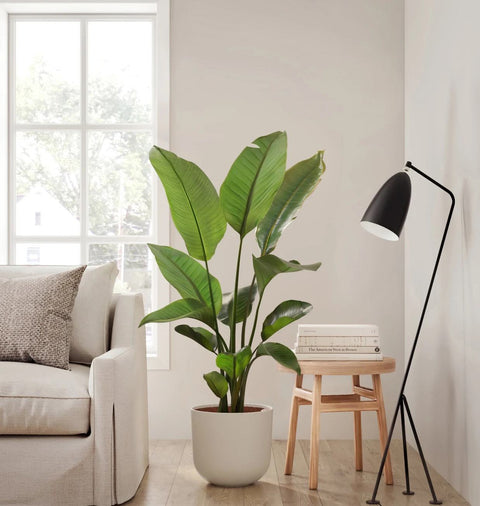Are you an avid houseplant keeper? Does the sight of your beloved houseplant's leaves turning yellow and brown fill your heart with dread? If yes, then you've come to the right place! In this article, we dive into six common reasons why leaves on your houseplants turn yellow or brown and cover the proper steps to revive them. So keep reading to learn more about houseplant care and preserving your plants to look vibrant and healthy!
What Causes Yellow Or Brown Leaves On Houseplants?
Common causes of yellow or brown leaves on houseplants include overwatering, underwatering, nutrient deficiencies, and extreme temperatures. Overwatering can cause the leaves on a houseplant to turn yellow due to a lack of oxygen reaching the roots. Underwatering can also cause yellow leaves because of the lack of moisture in the soil. Nutrient deficiencies can cause yellow or brown spots, patches, or streaks on houseplant leaves. Finally, extreme temperatures can cause houseplant leaves to turn yellow or brown due to heat or cold damage. With careful monitoring and regular maintenance, yellow or brown leaves on houseplants can be prevented or treated.
Underwatering
Underwatering can be one of the main reasons why your houseplant's leaves turn yellow or brown. The lack of water causes the leaves to become dry and wilted, which can lead to the yellowing of the leaves. This can also be identified by the leaves being brittle and easily breakable. Additionally, the soil may also appear too dry and hard. To prevent underwatering, ensure that your houseplant is regularly given adequate water. Inspect the soil to ensure it is moist and water if necessary. A great way to check if your houseplant needs water is to stick your finger into the soil; if it feels dry, then it needs to be watered. Constantly correctly water your houseplant, as proper watering is key to a healthy houseplant!

Overwatering
Overwatering is one of the most common causes of yellow or brown leaves on houseplants. When the soil of a houseplant is overwatered, the roots become deprived of oxygen, resulting in too much moisture in the ground. This can lead to yellowing or browning of the leaves due to a lack of oxygen to the entire plant. To avoid overwatering, allow the soil to dry out completely between watering sessions and check the moisture level before watering. Additionally, water houseplants more sparingly during the winter months, as the plant may not need as much water during these times.
Incorrect Light Levels
Incorrect light levels can be one of the main reasons why your houseplant leaves turn yellow or brown. When your houseplant receives too much light, the leaves will turn yellow and brown. On the other hand, if your houseplant is not receiving enough light, the leaves may turn lighter in color, which can also lead to yellow or brown leaves. Both instances can result in a weakened plant that fails to produce new leaves, so it is important to ensure that your houseplant has the correct light level. When caring for your houseplant, choose an area where the light is not too intense but also not too dark. Furthermore, it is essential to rotate your houseplant throughout the day to ensure it receives the optimal light.

Pests and Diseases
Common pests and diseases can cause the yellowing or browning of a houseplant's leaves. These include aphids, mealybugs, spider mites, scale, and bacterial and fungal diseases such as fusarium, powdery mildew, and root rot. Identifying the pest or disease is important as treating it quickly and appropriately. If a houseplant is healthy, yellowing leaves can be caused by improper watering or fertilizer usage, inadequate light, or an extreme temperature change. These factors can be easily adjusted to keep houseplants healthy and thriving.
How to Revive Your Yellow or Brown Houseplant Leaves
When you notice your houseplant's leaves turning yellow or brown, it is essential to identify and address the underlying cause quickly. The most common causes of yellow and brown leaves include overwatering or underwatering, too much direct sunlight or not enough light, nutrient deficiencies, or pest infestations.
To revive your yellow or brown houseplant leaves, start by determining the root cause of the problem. Once you've identified it, follow the steps recommended to resolve the issue. For example, if you've been overwatering your houseplant, adjust its watering schedule and check the soil for proper drainage. Additionally, if the leaves are too far gone to be saved, you can trim away the affected leaves and provide the plant with more light and fertilizer. These steps will help you return your houseplant to its healthy, vibrant self.
Check For Pests and Diseases
When you're keeping houseplants, it's important to check them regularly for pests and diseases that can cause yellow or brown leaves. To check for pests or diseases, examine the underside of the leaves for any small bugs, webs, or sticky patches. If you see any signs of pests or disease, you can treat them with a natural insecticide or fungicide. It's also beneficial to separate the infected houseplant from any other houseplants to prevent the spread of pests or diseases. Regularly checking your houseplants for pests and diseases can help ensure their good health.
Adjust Your Watering Schedule
One of the primary causes of yellow or brown leaves on your houseplants is incorrect watering schedules. Overwatering can cause root rot, leading to yellowing leaves, while underwatering can cause the leaves to become dry and brittle, leading to browning. To avoid such issues, make sure to adjust your watering schedule to suit the needs of the specific houseplant. Also, utilize your finger to check the soil before you water; if the top inch of soil is dry, it's time to water your houseplant. Your houseplants should stay healthy and vibrant with proper water schedule and plenty of care.
Provide The Right Amount Of Light
If your beloved houseplant's leaves are turning yellow or brown, it could be a sign that it is not receiving the right amount of light. Houseplants need light to photosynthesize and produce energy, so providing the right light is essential for healthy houseplants. If your houseplant is not receiving enough light, the leaves will begin to turn yellow or brown. If your houseplant is not getting enough sunlight, try moving it to a brighter area or providing more artificial light. With the right amount of light, your houseplant should thrive, keeping its leaves lush and vibrant.

Repot Into Fresh Soil
When yellow or brown leaves appear on your houseplant, it's usually an indication that repotting into fresh soil is needed. Houseplant roots need access to oxygen and nutrients which become depleted in soil over time. Repotting your houseplant into fresh soil will give it the nutrients it needs to thrive and keep those leaves looking bright and healthy. When repotting, it is essential to use lightweight soil that won't become compacted over time and allows for aeration. Providing your houseplant with occasional repotting will ensure it has the best environment to grow healthy and strong.
Preventing Yellow and Brown Leaves in The Future
Several proactive measures can be taken to prevent yellow and brown leaves on your houseplants in the future. First, ensure to water your houseplants regularly, keeping the soil evenly moist. Additionally, ensure to provide your houseplants with adequate light - different plants have varying needs, so make sure to research each houseplant's needs. Additionally, if your houseplant is showing yellow or brown leaves, make sure to prune it back. This will help to promote healthy new growth while getting rid of sickly-looking leaves. Lastly, make sure to clean the leaves of your houseplant regularly, as dust and other debris can accumulate on them, leading to yellow and brown leaves. Following these steps will help keep your houseplants healthy and flourishing for years.
Choose The Right Plant For Your Home And Lifestyle
Choosing the right houseplant for you and your lifestyle is essential for successful houseplant care. Consider where you live, the amount of light available, the temperature and humidity levels, and the amount of time you have to devote to plant care. If you select a plant that doesn't suit your needs or the home environment, you may face common houseplant problems such as yellow or brown leaves. Researching the needs of each plant can help you find the perfect fit for your home and lifestyle.

Understand Plant Needs Before Buying
Before deciding to purchase a houseplant, it's essential to research and understands the plant's needs. Different plants thrive in different environments and require additional lighting, moisture, and fertilization levels. If the plant is not given the right amount of light, water, or fertilizer, it can result in yellow or brown leaves, an indicator of stress on the plant. Knowing the requirements of the houseplant before buying it can help to ensure its successful growth and keep its leaves from turning yellow or brown. With a little research and preparation, you can provide your houseplants with the proper conditions for a healthy life.
Conclusion
Overall, by understanding the different reasons why houseplant leaves may turn yellow or brown and taking a few simple steps to address the problem, you can help to ensure that your houseplants remain healthy and vibrant for years to come. With a bit of time and effort, you can provide the perfect environment for your houseplants to thrive and grow into a lush addition to your home, whether a small pot of flowers or a large indoor jungle, taking the time to understand your houseplant's needs will ensure a happy and healthy life.





Comments (0)
There are no comments for this article. Be the first one to leave a message!